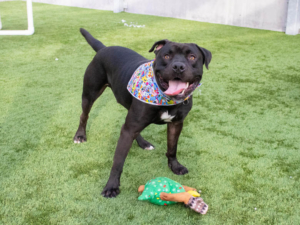Spread the love during National Walk Your Dog Month

Two-year-old Paco is goofy, active, and loves to play with toys (especially tennis balls)! Paco is available for a 14-day adoption trial so you can get to know him in the comfort of your own home.
At our home in the hills of West Pasadena, we have a back patio, rather than a backyard. So, every day is Walk Your Dog Day for me. I don’t have a choice.
For those of you with yards, it may be tempting to open the back door and forgo the walk. That’s why National Walk Your Dog Month in January reminds us that regular exercise outside the home is much better for us humans and our pets.
Leashing up your pup and strolling the block provides a variety of mental, emotional, and physical benefits that are hard to come by in the yard.
Regular walks help keep you and your pup in shape. Walking burns calories and can help your dog maintain a healthy weight, preventing obesity. Physical activity also keeps the joints moving, which is especially important for older dogs prone to stiffness and arthritis.
Walks are about more than just burning calories for our four-legged friends; they are a great source of mental stimulation. On a walk, they meet their human neighbors and other dogs while experiencing the sights and sounds of a residential neighborhood, like cars, bicycles, and local wildlife (SQUIRRELS!).
And don’t get me started on smells! My dog Sueshi loves to “read” every “pee mail” left by her canine friends. Those messages contain a wealth of information to decode, not to mention all that can be learned by a sniff of another dog’s private parts. These scents are one of the main ways dogs communicate.
Going for walks is a great way to spend quality time with your pup while doing something they love. A regular walking routine helps establish trust and builds confidence. You can also use a walk to practice your dog’s training, further strengthening your bond.
Plus, a tired dog is less likely to get into mischief. Expelling your pup’s excess energy on a walk can help reduce destructive behaviors caused by boredom, anxiety, or frustration.
Can there be too much of a good thing? The recommended frequency and duration of your dog’s walks will depend on factors such as age, breed, and health. Most dogs should enjoy at least one or two 15 to 30 minute walks per day. More active dogs need additional exercise, whereas senior dogs may enjoy shorter walks at a more relaxed pace.
Puppies should only go on walks outside once they have completed their primary vaccination series. Instead, opt for a puppy class, like those at Pasadena Humane, to help with socialization in a safe and controlled environment. Once your puppy is fully vaccinated, you can get them used to the leash and slowly build up the length of their walks.
If you dog is lacking basic leash manners, try teaching loose-leash walking. It may take some time, but with practice and patience, you can train a strong puller to walk calmly at your side. If you need more support, our Basics 101 training class can help!
One common obstacle to a successful walk is reactivity. If your dog is barking, lunging, or growling at other dogs, people, or moving objects, consider enrolling in a training class specially designed for reactive dogs. This winter, Pasadena Humane is offering classes for small and large breed “reactive rovers”.
With dry, sunny weather predicted for the next couple of weeks, take advantage of the rest of this month to reap the rewards of walking with your dog. And, if you would like to learn more about our upcoming training classes or register for a class, visit pasadenahumane.org/training.
Dia DuVernet is president and CEO of Pasadena Humane.
This blog post originally appeared as a column in the Pasadena Star-News print edition on January 21, 2023.


